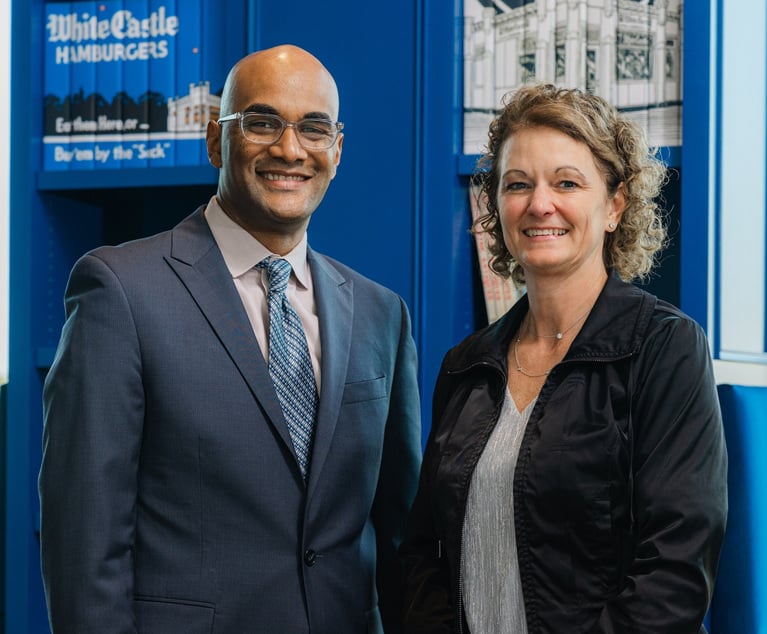Compliance Management Questions Linger
Debate continues to surround who should handle compliance.
April 30, 2010 at 08:00 PM
14 minute read
It wasn't until the advent of Sarbanes-Oxley (SOX) in 2002 that compliance became a standard component of corporate structure. But the prominence SOX directed toward compliance hasn't faded into the sunset. As legal trends go, it seems that the focus on compliance only increases in fervency.
The recessionary climate of the past two years certainly hasn't done anything to slow the movement. Securities and Exchange Commission (SEC) investigations, scrutiny of overseas activities under the Foreign Corrupt Practices Act (FCPA) and employment law issues have all contributed to the increased attention.
“Put simply, there are more laws than there used to be,” says Patrick Daugherty, a partner at Foley & Lardner.
But because the intense need for a compliance function is still relatively new, questions of who should fill the head compliance role and how to structure the program continually face debate.
“The activity level among regulators has clearly picked up over the last few years,” says Jay Mumford, global ethics and compliance director at Accenture. “Organizations need to be aware of that and need to be continually looking at what structures they've put in place to meet those requirements.”
Finding a Home
One of the biggest questions most companies face is who should lead compliance–the general counsel, another senior lawyer, a non-lawyer executive or a lower level auditor.
Who heads compliance depends on its function in a particular company, says Scott Mitchell, president and CEO of the Open Compliance and Ethics Group (OCEG). If the general counsel is a business partner who deals in executing strategic issues such as mergers and acquisitions, then it makes sense for that role to include compliance. But when the GC is primarily a litigator rather than business strategist, Mitchell says it makes more sense for someone else to assume that role–perhaps even someone outside the legal department.
“If compliance is led by someone who thinks primarily about litigation, his bias is going to be, 'How do we structure things so we don't get sued?'” he says. “That's an important element, but it should not drive the overall compliance structure.” Instead, Mitchell says compliance officers need to think like a business person.
Daugherty notes that nearly every in-house lawyer plays some role in compliance. Project-related compliance questions tend to be better served by legal departments because they beg the question of whether the ideas are legal. A company's day-to-day adherence to statutes, however, needn't necessarily be overseen by a lawyer.
Regardless, Daugherty says compliance works best when a defined officer is in charge. And in most cases, that officer should be a very experienced lawyer because the job is so varied.
“It requires the ability to assess a situation and act quickly, like an emergency room physician,” he says.
At the Helm
AGCO General Counsel Debra Kuper, who also oversees compliance, says it's crucial that the chief compliance role at her company be filled by a lawyer because so many of the compliance questions she encounters revolve around legal issues. The company hired her in 2008 specifically to strengthen its compliance program.
Now that the revamped compliance program is up and running, Kuper plans on divesting the chief compliance role from her GC duties within the next year. The role will be filled, however, by another senior-level attorney.
In Accenture's model, Mumford says compliance and ethics is embedded within the legal department, which then spreads the message of compliance throughout the company's infrastructure. Many compliance team members are lawyers who drive compliance functions related to their area of expertise, as well as the specific issues associated with the region in which they work.
Daugherty agrees that it's important to position specialists in compliance roles, particularly when dealing with global issues such as FCPA.
“Common sense is not an adequate guide to compliance,” he says. “You really need training, and there needs to be an ongoing system for monitoring and correcting small problems before they become large problems.”
Although a structure that intertwines ethics and compliance with legal has served Accenture well, Mumford says every company needs to find the structure that works best for its particular needs. “My question would be, has the organization constructed a structure for success that allows the global messages to be embedded into local vehicles and customized for the local audience?” he says. “If they've done that, they've done a very important thing.”
Sinking In
Whether a company's head of compliance has a J.D. or an MBA, compliance should be integrated into corporate culture from the ground up.
Mitchell says compliance programs can learn a lot from how quality control departments have evolved over the past few years. Initially, quality control involved catching problems in the finished product. The second phase built quality checks by a manager into the assembly line. In the final phase, each person running a machine held responsibility for ensuring quality.
“The idea that really resonates for me is that every employee is part of the compliance staff,” Mitchell says.
Kuper strengthened AGCO's compliance program by creating a top-to-bottom system composed of both lawyers and non-lawyers. Under her supervision, regional ethics and compliance officers, who are attorneys, evaluate risk. Non-lawyers in local, onsite compliance roles do more administrative tasks, such as running names on terror watch lists. When a red flag goes up, they send the information to the regional level for assessment.
She says she sees her role like that of an orchestra's conductor, making sure all of the pieces work together. “People are really open and teachable,” she says. “They will pick up [responsibility] and run with it.”
Mumford says the key to successful compliance is embedding the function into every employee. He suggests that scandal-plagued companies often tacked on compliance programs–sometimes very thorough- looking from the outside–without altering the basic company culture.
“The legal team needs to take ownership,” he says. “Building in compliance instead of bolting it on is much more effective in getting rules followed.”
Ultimately successful compliance depends on how well the program is implemented, regardless of who takes the reins.
“Ethics and compliance can be successful as part of legal. It can be successful outside of legal. It really depends on the organizational culture that you're looking at,” Mumford says. “You cannot succeed in spite of people. You can only succeed in tandem with people.”
It wasn't until the advent of Sarbanes-Oxley (SOX) in 2002 that compliance became a standard component of corporate structure. But the prominence SOX directed toward compliance hasn't faded into the sunset. As legal trends go, it seems that the focus on compliance only increases in fervency.
The recessionary climate of the past two years certainly hasn't done anything to slow the movement. Securities and Exchange Commission (SEC) investigations, scrutiny of overseas activities under the Foreign Corrupt Practices Act (FCPA) and employment law issues have all contributed to the increased attention.
“Put simply, there are more laws than there used to be,” says Patrick Daugherty, a partner at
But because the intense need for a compliance function is still relatively new, questions of who should fill the head compliance role and how to structure the program continually face debate.
“The activity level among regulators has clearly picked up over the last few years,” says Jay Mumford, global ethics and compliance director at
Finding a Home
One of the biggest questions most companies face is who should lead compliance–the general counsel, another senior lawyer, a non-lawyer executive or a lower level auditor.
Who heads compliance depends on its function in a particular company, says Scott Mitchell, president and CEO of the Open Compliance and Ethics Group (OCEG). If the general counsel is a business partner who deals in executing strategic issues such as mergers and acquisitions, then it makes sense for that role to include compliance. But when the GC is primarily a litigator rather than business strategist, Mitchell says it makes more sense for someone else to assume that role–perhaps even someone outside the legal department.
“If compliance is led by someone who thinks primarily about litigation, his bias is going to be, 'How do we structure things so we don't get sued?'” he says. “That's an important element, but it should not drive the overall compliance structure.” Instead, Mitchell says compliance officers need to think like a business person.
Daugherty notes that nearly every in-house lawyer plays some role in compliance. Project-related compliance questions tend to be better served by legal departments because they beg the question of whether the ideas are legal. A company's day-to-day adherence to statutes, however, needn't necessarily be overseen by a lawyer.
Regardless, Daugherty says compliance works best when a defined officer is in charge. And in most cases, that officer should be a very experienced lawyer because the job is so varied.
“It requires the ability to assess a situation and act quickly, like an emergency room physician,” he says.
At the Helm
AGCO General Counsel Debra Kuper, who also oversees compliance, says it's crucial that the chief compliance role at her company be filled by a lawyer because so many of the compliance questions she encounters revolve around legal issues. The company hired her in 2008 specifically to strengthen its compliance program.
Now that the revamped compliance program is up and running, Kuper plans on divesting the chief compliance role from her GC duties within the next year. The role will be filled, however, by another senior-level attorney.
In
Daugherty agrees that it's important to position specialists in compliance roles, particularly when dealing with global issues such as FCPA.
“Common sense is not an adequate guide to compliance,” he says. “You really need training, and there needs to be an ongoing system for monitoring and correcting small problems before they become large problems.”
Although a structure that intertwines ethics and compliance with legal has served
Sinking In
Whether a company's head of compliance has a J.D. or an MBA, compliance should be integrated into corporate culture from the ground up.
Mitchell says compliance programs can learn a lot from how quality control departments have evolved over the past few years. Initially, quality control involved catching problems in the finished product. The second phase built quality checks by a manager into the assembly line. In the final phase, each person running a machine held responsibility for ensuring quality.
“The idea that really resonates for me is that every employee is part of the compliance staff,” Mitchell says.
Kuper strengthened AGCO's compliance program by creating a top-to-bottom system composed of both lawyers and non-lawyers. Under her supervision, regional ethics and compliance officers, who are attorneys, evaluate risk. Non-lawyers in local, onsite compliance roles do more administrative tasks, such as running names on terror watch lists. When a red flag goes up, they send the information to the regional level for assessment.
She says she sees her role like that of an orchestra's conductor, making sure all of the pieces work together. “People are really open and teachable,” she says. “They will pick up [responsibility] and run with it.”
Mumford says the key to successful compliance is embedding the function into every employee. He suggests that scandal-plagued companies often tacked on compliance programs–sometimes very thorough- looking from the outside–without altering the basic company culture.
“The legal team needs to take ownership,” he says. “Building in compliance instead of bolting it on is much more effective in getting rules followed.”
Ultimately successful compliance depends on how well the program is implemented, regardless of who takes the reins.
“Ethics and compliance can be successful as part of legal. It can be successful outside of legal. It really depends on the organizational culture that you're looking at,” Mumford says. “You cannot succeed in spite of people. You can only succeed in tandem with people.”
This content has been archived. It is available through our partners, LexisNexis® and Bloomberg Law.
To view this content, please continue to their sites.
Not a Lexis Subscriber?
Subscribe Now
Not a Bloomberg Law Subscriber?
Subscribe Now
NOT FOR REPRINT
© 2025 ALM Global, LLC, All Rights Reserved. Request academic re-use from www.copyright.com. All other uses, submit a request to [email protected]. For more information visit Asset & Logo Licensing.
You Might Like
View All
White Castle GC Becomes Chain's First President From Outside Family

Beyond the Title: Developing a Personal Brand as General Counsel
Trending Stories
Who Got The Work
Michael G. Bongiorno, Andrew Scott Dulberg and Elizabeth E. Driscoll from Wilmer Cutler Pickering Hale and Dorr have stepped in to represent Symbotic Inc., an A.I.-enabled technology platform that focuses on increasing supply chain efficiency, and other defendants in a pending shareholder derivative lawsuit. The case, filed Oct. 2 in Massachusetts District Court by the Brown Law Firm on behalf of Stephen Austen, accuses certain officers and directors of misleading investors in regard to Symbotic's potential for margin growth by failing to disclose that the company was not equipped to timely deploy its systems or manage expenses through project delays. The case, assigned to U.S. District Judge Nathaniel M. Gorton, is 1:24-cv-12522, Austen v. Cohen et al.
Who Got The Work
Edmund Polubinski and Marie Killmond of Davis Polk & Wardwell have entered appearances for data platform software development company MongoDB and other defendants in a pending shareholder derivative lawsuit. The action, filed Oct. 7 in New York Southern District Court by the Brown Law Firm, accuses the company's directors and/or officers of falsely expressing confidence in the company’s restructuring of its sales incentive plan and downplaying the severity of decreases in its upfront commitments. The case is 1:24-cv-07594, Roy v. Ittycheria et al.
Who Got The Work
Amy O. Bruchs and Kurt F. Ellison of Michael Best & Friedrich have entered appearances for Epic Systems Corp. in a pending employment discrimination lawsuit. The suit was filed Sept. 7 in Wisconsin Western District Court by Levine Eisberner LLC and Siri & Glimstad on behalf of a project manager who claims that he was wrongfully terminated after applying for a religious exemption to the defendant's COVID-19 vaccine mandate. The case, assigned to U.S. Magistrate Judge Anita Marie Boor, is 3:24-cv-00630, Secker, Nathan v. Epic Systems Corporation.
Who Got The Work
David X. Sullivan, Thomas J. Finn and Gregory A. Hall from McCarter & English have entered appearances for Sunrun Installation Services in a pending civil rights lawsuit. The complaint was filed Sept. 4 in Connecticut District Court by attorney Robert M. Berke on behalf of former employee George Edward Steins, who was arrested and charged with employing an unregistered home improvement salesperson. The complaint alleges that had Sunrun informed the Connecticut Department of Consumer Protection that the plaintiff's employment had ended in 2017 and that he no longer held Sunrun's home improvement contractor license, he would not have been hit with charges, which were dismissed in May 2024. The case, assigned to U.S. District Judge Jeffrey A. Meyer, is 3:24-cv-01423, Steins v. Sunrun, Inc. et al.
Who Got The Work
Greenberg Traurig shareholder Joshua L. Raskin has entered an appearance for boohoo.com UK Ltd. in a pending patent infringement lawsuit. The suit, filed Sept. 3 in Texas Eastern District Court by Rozier Hardt McDonough on behalf of Alto Dynamics, asserts five patents related to an online shopping platform. The case, assigned to U.S. District Judge Rodney Gilstrap, is 2:24-cv-00719, Alto Dynamics, LLC v. boohoo.com UK Limited.
Featured Firms
Law Offices of Gary Martin Hays & Associates, P.C.
(470) 294-1674
Law Offices of Mark E. Salomone
(857) 444-6468
Smith & Hassler
(713) 739-1250








